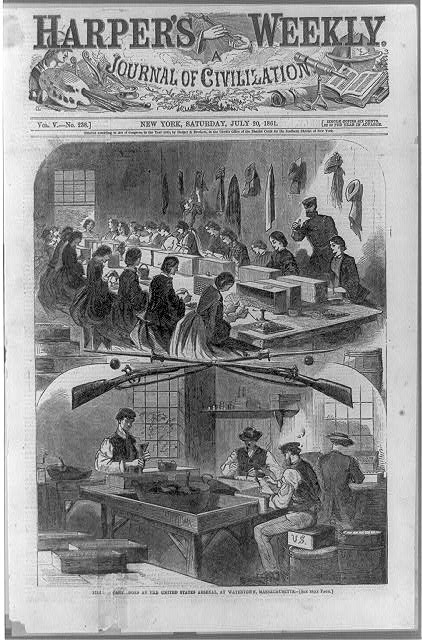The Richmond Bread Riots, Part I
Today, we welcome back guest author Ashley Webb.
By 1863, Richmond was a major railway hub, an industrial center of the South, and the burgeoning capital of the Confederacy. With the continuation of the Civil War, large influxes of soldiers came and went, and people crowded into the capital looking for work. With the blockade on Southern ports, the deterioration and destruction of Southern railroads, and the confiscation of food for soldiers, shortages continued, raising prices on necessities. Many families struggled to survive, widening the gap between Richmond’s elite and poor. The culmination of these factors led to a riot on April 2, 1863, composed of women, children, and a handful of men. They marched through several of downtown Richmond’s streets, looting stores and calling for an audience with the governor. Despite being written off as a comical occurrence in years after the war, this riot reinforced and emphasized the hardships of the Civil War on the Confederate home front.
Several events in addition to the rise in population and inflation immediately prior to April 2 pushed Richmond’s citizens past a breaking point. First, starting in November of 1862, and continuing into February of 1863, Richmond was the site of a smallpox epidemic.[i] Both soldiers stationed in Richmond and individuals of the poorest classes succumbed to the disease, with it spreading rampant through the cramped living conditions throughout the city. Dr. Albert Snead, physician at Howard’s Grove Hospital, Richmond’s ‘smallpox hospital,’ wrote in a letter dated January 1863, “I have had charge of the City Hospital for about ten years, and never during that time has there been so extensive prevalence of small-pox, nor has the percentage of mortality risen so high as during this visitation [of smallpox]. Not only among the soldiers who have been under my care, but also among the resident population, the mortality has been fearfully great….”[ii] Close living quarters, lack of correct hygiene, as well as the lack of fresh food helped spread smallpox throughout the city.

Second, an explosion in the Brown’s Island munitions on March 13, 1863, injured 69 individuals, 56 of whom were known to be young women and teenagers of the poorer classes.[iii] While the general public seemed to feel sympathy for the families of those involved, this explosion reinforced the fact that women and children needed to handle many of the dangerous jobs men couldn’t do while away from home, fighting in the war.
Third, the harsh winter of 1862-1863 played a role in activating Richmond’s bread riot. Heavy snows damaged the water system in the poorest sections of the city, sending families to the river or an antiquated well in Capitol Square for water. Heavy snow also made the roads into and out of the city impassable. The week just before the riot, more than a foot of snow fell, preventing the transport of additional fruits, vegetables, and meats into Richmond. J.B. Jones, a war clerk for the Confederacy, commented in his diary on March 22, 1863, on the snow and it’s relation to the scarcity of food: “The snow has laid an embargo on the usual slight supplies brought to market, and all who had made no provision for such a contingency are subsisting on very short-commons.”[iv] The next day Jones wrote, “The snow has nearly disappeared, and the roads are very bad. No food is brought to the market, and such as may be found in the city is held at famine prices.”[v] Despite the snow, food was already scarce. The snow benefited extortionists, who inflated the prices on food, clothing, and other necessities.

Fourth, Confederate president Jefferson Davis requested a day of fasting and prayer on March 27, furthering the rift between social classes and making a mockery of what most citizens had already given up for the Confederate cause. On this announcement, Confederate war clerk, J.B. Jones declared, “Fasting amidst famine! May God save this people!”[vi] Richmond wasn’t the only Southern city feeling this same discontent in early 1863. The Richmond bread riot, although the most notable, was one of many small riots that occurred throughout the South. In the month preceding the Richmond riot, three other riots occurred: one in Salisbury, North Carolina, and a second in Atlanta, Georgia, and a third in Mobile, Alabama. The riots in North Carolina and Georgia made it to the pages of Richmond’s Daily Dispatch, on March 25th and March 30th respectively. [vii] Both groups were somewhat successful from their uprisings, purchasing goods at government prices. Regardless, the organizers of the Richmond riot surely saw these reports, or heard mention of the success reaped from them.
To be continued….
————
[i] Blakey, Arch Fredric. General John H. Winder; C.S.A., (Gainesville: University of Florida Press, 1990), 146.
[ii] United States Sanitary Commission. Sanitary Memoirs of the War of the Rebellion, Volume 1 (Cambridge: Riverside Press, 1867), 611.
[iii] “Gunpowder explosion,” New York Daily Tribune. 12 March 1863. Chronicling America: Historic American Newspapers. http://chroniclingamerica.loc.gov/lccn/sn83030213/1863-03-21/ed-1/seq-1/; “The Late Dreadful Explosion on Brown’s Island,” The Daily Dispatch. 16 March 1863. Perseus. http://www.perseus.tufts.edu/hopper/text?doc=Perseus%3Atext%3A2006.05.0698%3Aarticle%3Dpos%3D11
[iv] Jones, J.B. A Rebel War Clerk’s Diary at the Confederate States Capital, (Philadelphia: J.B. Lippincott & Co, 1866), 278.
[v] Ibid, 278.
[vi] Ibid, 280.
[vii] “Another Female Impressment,” The Daily Dispatch. 15 March 1863. Perseus. http://www.perseus.tufts.edu/hopper/text?doc=Perseus%3Atext%3A2006.05.0709%3Aarticle%3D9; “Impressment by Women-A Rich Scene,” The Daily Dispatch. 30 March 1863. Perseus. http://www.perseus.tufts.edu/hopper/text?doc=Perseus%3Atext%3A2006.05.0706%3Aarticle%3D5
2 Responses to The Richmond Bread Riots, Part I